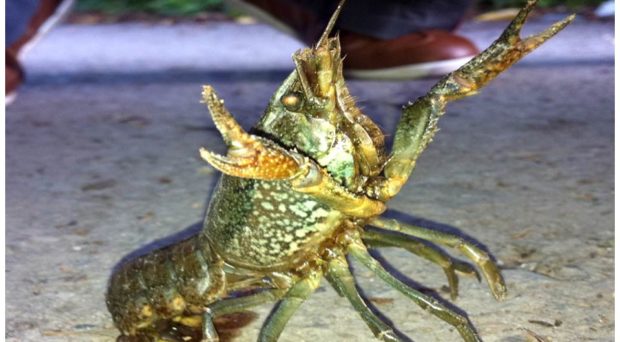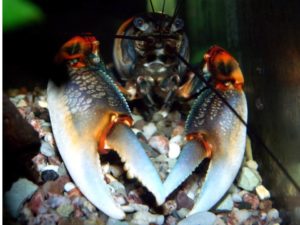
Freshwater crayfish are fascinating animals. They look like miniature lobsters, are capable of a wide spectrum of behaviors (e.g., complex intraspecific interactions, individual recognition, and formation of social hierarchies), and some species feature eye-catching colorations that can easily rival ornamental fish.
Therefore, it came as no surprise when crayfish first appeared in the German pet trade in the early 1990s. Exotic crayfish farmed for live food trade made their debut as an alternative for classic aquarium fishes at the time. Soon after, crayfish became increasingly popular among aquarium hobbyists, and by the mid-2000s, keeping of crayfish in home aquaria had eventually turned into a `crayfish hype´. And within a decade, crayfish have made it onto the stock lists of virtually all aquarium shops and importers.
Crayfish however, are also key players in aquatic ecosystems. Their omnivorous feeding habits, search for food and living activity as well as their size make them keystone species that do not fit neatly into typical home aquarium communities. Crayfish tend to destroy plants and may prey on aquarium animals. Some species can also easily outgrow or overpopulate their tanks. This holds especially true for the all-female, self-cloning species (parthenogenetic Marmorkrebs) with essentially unrestricted reproduction. Aquarium hobbyists are therefore likely to want to offload unwanted crayfish or excess stock into nature.
Non-invasive crayfish
The rapidly growing market for pet crayfish has therefore raised a major concern: the release of non-native crayfish species into natural habitats. Indeed, there is striking evidence to suggest that the pet trade has become a novel and major pathway for non-native crayfish species introductions in Europe.
Invasive non-native crayfish can wreak ecological havoc.
This problem is especially prevalent in Europe, where several crayfishes of North American origin are displacing native crayfish, which are now of major conservation concern. The invaders are often more competitive than their native counterparts and also brought their own biological weapon: the oomycete Aphanomyces astaci. This parasite does not usually harm its natural North American hosts but inflicts a fatal disease on native European crayfish, aptly named `crayfish plague´.
The purpose of the featured paper was to assess the bioinvasion risk associated with the growing market for pet crayfish and to identify the determinants of crayfish releases from aquaria. Specifically, I used an invasiveness-screening tool (FI-ISK) to assess the potential invasiveness (i.e. the potential to establish and spread, and to cause ecological or economic damage) of crayfish species offered through e-commerce. Based on related research on aquarium fishes, I argued that crayfish species introduced from aquaria are: 1) widely available and inexpensive in the pet trade, and 2) typically larger than pet crayfish species that have not been introduced. To evaluate this hypothesis, two datasets on the German market for pet crayfish were analyzed.

Many species
In total, 120 non-native crayfish species have been available as ornamental aquarium species until mid-2009. This number represents roughly one fifth of the global species pool of crayfish and 40-fold the number of native crayfish species to be found in Germany (i.e. three). Of the 120, 105 species originate from North or Central America and were therefore, suspected to be crayfish plague vectors – an argument that was later supported by follow-up studies.
Despite many species being imported, only 20 species were found to be common in the trade. Statistical analysis showed that species’ availability and size were the principal predictors of the likelihood of being recorded as introduced from aquaria. Non-native crayfish introduced from aquaria were found to be more available and larger than those present only in aquaria, and their potential invasiveness was also higher. A greater availability is likely related to more release events, and large species may be released more frequently as a result of overpopulating or outgrowing their aquaria.
Of course, the issue of pet releases is much broader than ornamental crayfish (for example: lionfish invading the Caribbean and persistent red-eared slider turtle releases in Europe). The identified pattern, however, presumably holds true for many aquarium pets: popular and large species are more likely to be introduced into natural habitats than rarely sold, small species.
This phenomenon becomes problematic, when – as shown in my study for ornamental crayfish – popular aquarium species include high-risk species that are likely to cause ecological or economic damage once released. In such cases, risk mitigation is strongly suggested. Because prevention of introduction is much more efficient and feasible than costly eradication after establishment, management measures should primarily aim to reduce the availability of known high-risk species. To this end, proactive efforts such as voluntary self-regulation of the trade, customer education, and policy measures, including trade regulations, have been repeatedly proposed – a serious challenge in an as-yet generally unregulated industry.
Read full journal article: Invaders for sale: trade and determinants of introduction of ornamental freshwater crayfish